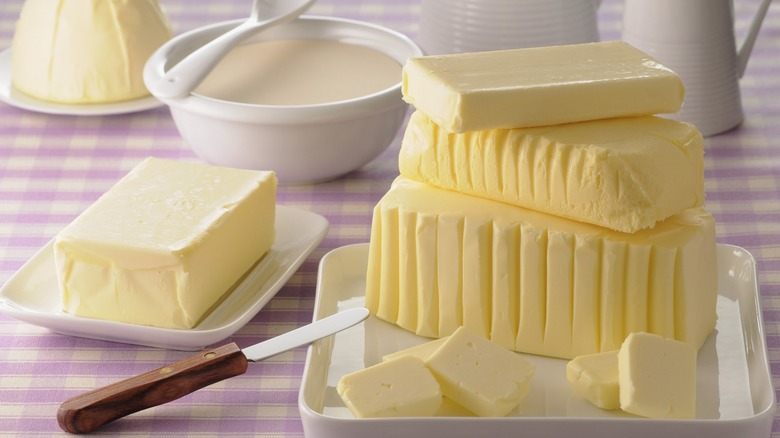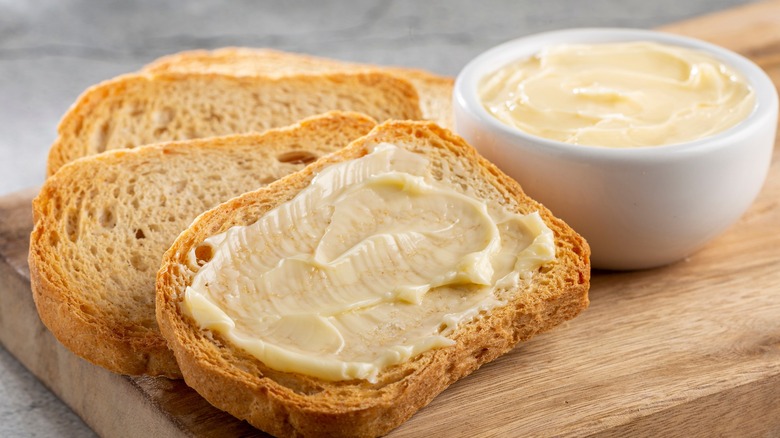What's The Difference Between Sweet Cream And Regular Butter?
Going through the dairy aisle, there's a good chance you'll come across various butter styles from different brands. Granted, most already know the difference between salted and unsalted butter (hint, it's salt), but what's the distinction between sweet cream butter and the everyday variety? Well, the short answer is there isn't one — regardless of whether a package of butter has the words "sweet cream" on it, you'll more than likely be purchasing the same thing.
That's not to say that it's simply a marketing ploy. Instead, the phrase should be considered more of a technical term or descriptor, particularly since butter does have types. According to acclaimed food writer and cookbook author (which also includes the book "Butter") Dorie Greenspan, butter comes in three distinct varieties: sweet, high fat, and cultured. Additionally, each classification has specific contrasting characteristics that distinguish them, which are essential when determining the right product to grab at the grocery store.
The differences between the three types of butters
Because sweet cream and regular butter are the same (read: each doesn't contain sugar), it can also be described as American-style butter, which is an excellent descriptor since the laws of the United States dictate that butter must possess at least 80% fat. This is significant because, as Zingermans' Ari Weinzweig told Greenspan, most producers adhere to this benchmark to a fault by extracting the excess fat (apparently, the majority of butter inherently contains around 82%). And they aren't the only ones to state that fact. As Organic Valley's Senior Food Technologist Sam Barton (per Epicurious) illustrates, it's a common practice: "Let's say we churn that butter and it's 84% ... well, most places would say we're gonna add back water to get right to 80." Either way, this style is typically made with cream — hence, the name.
Unfortunately, sweet cream butter can't be classified as European butter, which tends to have anywhere between 82% and 90% butterfat, making it high fat. Still, according to some professional bakers, the contrast between the butter found in America and its overseas counterpart makes a load of difference, especially when creating croissants.
Then there's cultured butter, the most diverse of the bunch, and a subcategory of European styles. Bacteria play a role in its production, since the cream undergoes fermentation and forms the same living cultures as yogurt or sour cream, giving it some acidity and a different texture.
When to use sweet cream butter
Because sweet cream butter and plain butter are interchangeable, you assumably use it already. As an everyday staple in most grocery stores, sweet cream butter is often used in baking, cooking, compound butter, and creating spreads like the popular butter board, so keep doing you. However, you may not have known there are some disadvantages to using American butter rather than European-style varieties.
For instance, aside from having less fat, sweet cream butter doesn't possess as high a smoking point as European butter. This is because, similar to clarified butter, European butter doesn't have as much water. But remember, it's not a replacement since the former completely removes water and milk solids.
Moreover, if you want to show off some butter, like on a butter board, European styles have a darker, more vibrant color than sweet cream butter because of what the cows used to produce the product eat. In most cases, they're fed grass with beta-carotene in it. Nevertheless, whether you purchase a package of sweet cream or American-style butter or its much fattier (and possibly tangier) European relative, you can start a conversation about the differences over a spread.


